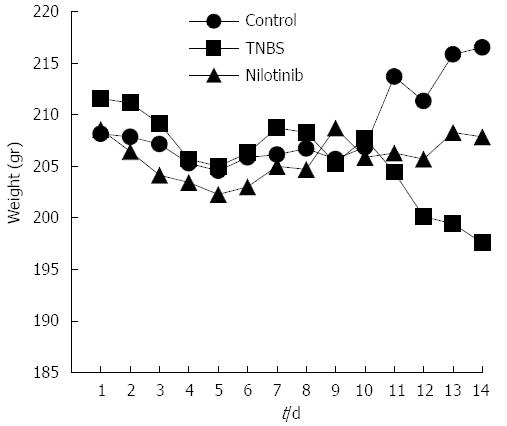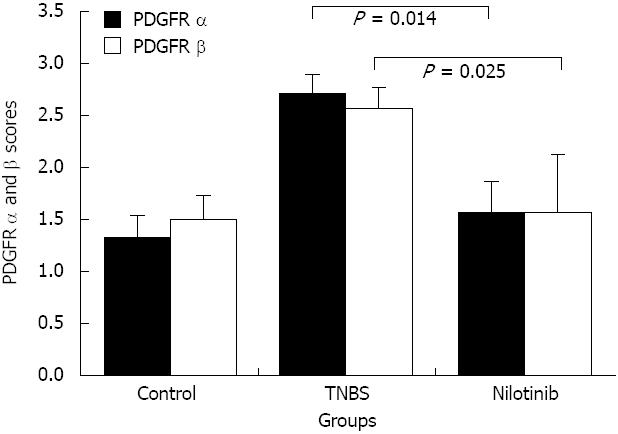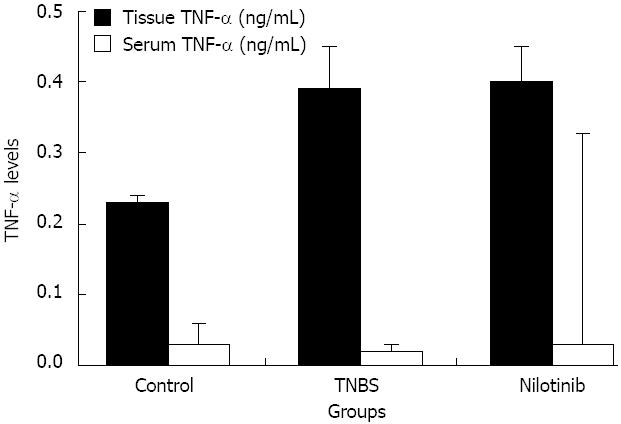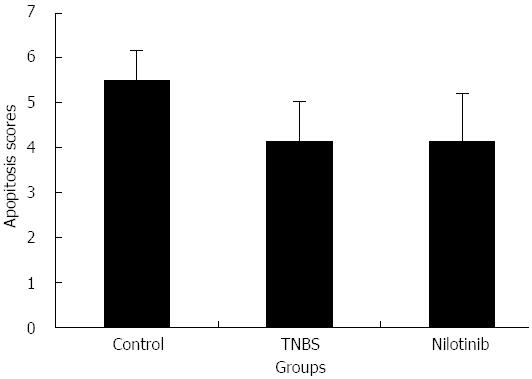Copyright
©2013 Baishideng Publishing Group Co.
World J Gastroenterol. Oct 7, 2013; 19(37): 6237-6244
Published online Oct 7, 2013. doi: 10.3748/wjg.v19.i37.6237
Published online Oct 7, 2013. doi: 10.3748/wjg.v19.i37.6237
Figure 1 Trends of weight changes among the experimental groups.
Control group (circle), Trinitrobenzene sulfonic acid (TNBS) group (square), and nilotinib group (triangle). The TNBS group lost an average weight of 14 g, while the nilotinib group lost 0.7 g in 14 d (P = 0.047). The nilotinib group gained an average weight of 2.9 g between day 7 and day 14, while the TNBS group lost an average weight of 11.1 g (P = 0.015).
Figure 2 Microscopic and macroscopic pathological scores among the experimental groups.
The results are the mean ± SD. Macroscopic and microscopic pathological scores were similar in the control and nilotinib groups, while the scores in the nilotinib group were significantly lower than those in the trinitrobenzene sulfonic acid (TNBS) group (TNBS vs nilotinib, P = 0.009; TNBS vs nilotinib, P = 0.030).
Figure 3 Platelet-derived growth factor receptor alpha and beta scores among the experimental groups.
The results are the mean ± SD. Platelet-derived growth factor receptor (PDGFR) alpha and beta scores were similar in the control and nilotinib groups, while the scores in the nilotinib group were significantly lower than those in the trinitrobenzene sulfonic acid (TNBS) group (TNBS vs nilotinib, P = 0.014; TNBS vs nilotinib, P = 0.025).
Figure 4 Tissue and serum tumor necrosis factor α levels among the experimental groups.
The results are the mean ± SD. Serum tumor necrosis factor (TNF) and tissue TNF α levels were similar between the trinitrobenzene sulfonic acid (TNBS) and nilotinib groups.
Figure 5 Apoptosis scores among the experimental groups.
The results are the mean ± SD. Apoptosis scores were similar among the groups. TNBS: Trinitrobenzene sulfonic acid.
- Citation: Ataca P, Soyturk M, Karaman M, Unlu M, Sagol O, Dervis Hakim G, Yilmaz O. Nilotinib-mediated mucosal healing in a rat model of colitis. World J Gastroenterol 2013; 19(37): 6237-6244
- URL: https://www.wjgnet.com/1007-9327/full/v19/i37/6237.htm
- DOI: https://dx.doi.org/10.3748/wjg.v19.i37.6237













